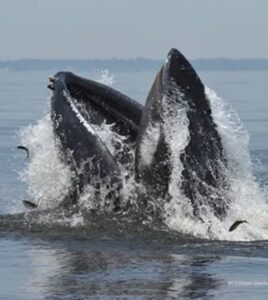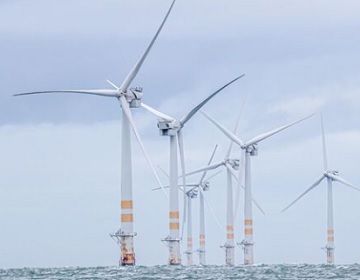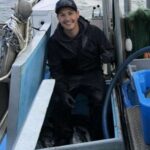Tag Archives: Ph.D.
72 whales have died on the East Coast in a year. NOAA must take action.
 So, what have we learned from the recent whale deaths off the East Coast — 72 since December 2022? They have compelled local communities to question the risks and benefits of offshore wind. Sadly, these same deaths have revealed a disturbing lack of curiosity among the oil-companies-turned-offshore-wind-developers, the National Oceanic and Atmospheric Administration and even some marine scientists who rush to the cameras every time a whale dies to point fingers away from offshore wind development along the eastern seaboard. Proponents of offshore wind are quick to blame global warming (to which of course their solution is offshore wind turbines) moving feeding grounds into shipping lanes and general episodic “vessel strikes” for these deaths. Many hope to close the investigation within the same day or two because the last thing they need is to have two dead whales, less than 30 miles apart, stealing the headlines for a full week. Proponents of these systems are also quick to claim that offshore wind will not harm marine mammals, yet their own action seemingly contradicts that. >>click to read<< 16:49
So, what have we learned from the recent whale deaths off the East Coast — 72 since December 2022? They have compelled local communities to question the risks and benefits of offshore wind. Sadly, these same deaths have revealed a disturbing lack of curiosity among the oil-companies-turned-offshore-wind-developers, the National Oceanic and Atmospheric Administration and even some marine scientists who rush to the cameras every time a whale dies to point fingers away from offshore wind development along the eastern seaboard. Proponents of offshore wind are quick to blame global warming (to which of course their solution is offshore wind turbines) moving feeding grounds into shipping lanes and general episodic “vessel strikes” for these deaths. Many hope to close the investigation within the same day or two because the last thing they need is to have two dead whales, less than 30 miles apart, stealing the headlines for a full week. Proponents of these systems are also quick to claim that offshore wind will not harm marine mammals, yet their own action seemingly contradicts that. >>click to read<< 16:49

A portrait of offshore wind companies
All of the prominent offshore wind companies originated in the oil and gas industry: Ørsted (Danish Oil and Natural Gas), Equinor (Norwegian Statoil), British Petroleum, Avangrid (Spanish Iberdrola gas), and Shell Oil (Dutch/UK). These past enemies of environmentalists, now dancing partners, continue to generate revenue from fossil fuels. Ørsted even profited from burning coal this past year. Given the industry’s history of misleading the public about climate change, it’s not unreasonable to question their assertions now. These companies lose money from offshore wind operations. However, backed by generous upfront government subsidies, the ongoing construction of wind farms compensates for these losses. Because federal subsidies will contribute 30% of the capital costs, taxpayers will pay these predominantly foreign-owned, for-profit companies, billions of dollars. Orsted predicts that South Fork Wind will cost $53 million per turbine. >click to read< 11:27

Feds push ignorance defense for whale killing by offshore wind development
The Bureau of Ocean Energy Management and the NOAA Fisheries agency have both put out what amount to “arguments from ignorance” claiming that offshore wind development has nothing to do with the recent whale deaths. “We know nothing about it so it must not be happening” is a ridiculous defense to the charge of offshore wind development causing the death of a lot of whales. But this is exactly what the Feds are now saying. NOAA Fisheries is a scientific agency and their version is more scientific, which is important because this is really a scientific issue. Let us look at their arguments. >click to read< 17:38

Biden’s Latest Green Energy Victim: The Lobster Industry
One of President Joe Biden’s most disgusting “Nero fiddles while Rome burns” moments came when he hosted his first state dinner for visiting French President Emmanuel Macron. While the president and his guests gorged themselves on 200 live Maine lobsters poached in butter, his administration did everything it could to regulate the Maine fishing industry, particularly lobstermen. out of existence. And they’re making the fishing industry a scapegoat for the actual peril lurking in the waters off New England — offshore wind farms. >click to read < 15:04
Letter: NOAA supports, relies on SMAST fisheries work – William A. Karp, Ph.D. Science and Research Director, U.S. Department of Commerce/NOAA
 May 12, 2013 12:00 AM – I am writing in response to Steve Urbon’s May 3 article (“Watch out, NOAA — SMAST is innovating again”) regarding recent research led by Dr. Kevin Stokesbury and his colleagues at the UMass School of Marine Science and Technology using video to count fish in a trawl net. continued
May 12, 2013 12:00 AM – I am writing in response to Steve Urbon’s May 3 article (“Watch out, NOAA — SMAST is innovating again”) regarding recent research led by Dr. Kevin Stokesbury and his colleagues at the UMass School of Marine Science and Technology using video to count fish in a trawl net. continued
Predator, prey balance needed in fisheries management Carmine Gorga, Ph.D.
To the editor:
Congratulations to Matt Mullin, deputy regional director, New England Oceans Program, Environmental Defense Fund! He is the first member of the fisheries “establishment” who has publicly admitted to the need to account for the “predator and prey balance” (Letter, the Times, Nov, 14). This is a very important communication.
There is now hope that sooner or later even the National Oceanic and Atmospheric Administration and its National Marine Fisheries Service will eventually look at stocks of fish as existing in a web of interrelationships with each other, rather than in linear formation as they were depicted in ancient biology books. There is now hope that overfishing will no longer be attributed to the pitiful family fishing fleet!
Just imagine a world in which NOAA and NMFS acknowledge their boundaries, a world in which they leave the family fishing fleet alone. A world in which they get up the gumption to go after the large, often subsidized, national and international corporations, at times culprits for the devastation of the fisheries. Just imagine a world in which NOAA and NMFS call for a balanced management of pelagics (mid-water fish) and bottom fish!
Carmine Gorga, Ph.D.
Middle Street,
Gloucester










































